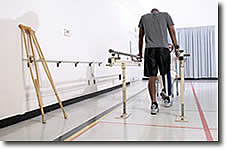 For patients with vascular disease or those with a traumatic injury due to the loss of a limb, the Amputee Rehabilitation Program offers compassionate, state-of-the-art care in a comfortable setting. Losing a limb is a devastating blow for anyone. It requires a team of professionals to make the adjustment to life without the limb. A physician, a prosthetist, nurses, and a physical therapist are all needed.
For patients with vascular disease or those with a traumatic injury due to the loss of a limb, the Amputee Rehabilitation Program offers compassionate, state-of-the-art care in a comfortable setting. Losing a limb is a devastating blow for anyone. It requires a team of professionals to make the adjustment to life without the limb. A physician, a prosthetist, nurses, and a physical therapist are all needed.
The benefits of physical therapy for amputee rehabilitation are numerous. For one, amputees will need help in overcoming phantom pain. These are pains where the limb used to be. The sensation really is in the nerve that would lead to that limb if it were still there. Physiotherapy has techniques to treat this pain.
Most amputees receive a prosthetic limb. Some feel that it should be enough to learn how to put it on. Getting full use from a prosthesis is not automatic. Many patients have prostheses for years without learning to use them properly. This is one reason amputee rehabilitation is so important.
Physical Therapy can benefit amputee rehabilitation by gradually getting the patient accustomed to using a prosthetic limb. The physical therapy plan for this will be based upon the needs and abilities of the patient.
The patient will probably need help during amputee rehabilitation to learn balance all over again. This is especially true is the affected limb is a foot or leg. However, having an arm that is of a different weight than the other may be unbalancing as well. Physical therapy can help with these problems too.
One thing people going through amputee rehabilitation need to realize is that gait is a good deal of the battle. If one walks correctly, people will not even be able to detect one’s limp, even with a prosthetic leg. This skill can be learned from physical therapists.
As patients progress through the program, they gain the strength and confidence they need to perform basic daily living skills and pursue active, independent lifestyles.
The Interdisciplinary Team:
When they arrive, patients are evaluated by a dedicated, experienced, interdisciplinary team. Once this initial assessment is complete, the team meets to coordinate care, develop an individualized treatment plan, set rehabilitation goals and establish a projected discharge date.
Depending on the patient’s unique needs, the members of his or her interdisciplinary team may include physicians with specialty training in physical medicine and rehabilitation; neurologists; certified rehabilitation nurses; case managers; physical, occupational, recreational and respiratory therapists; speech-language pathologists; clinical dietitians; psychologists; and a prosthetist/orthotist.
A Comprehensive Treatment Approach
During their stay, patients receive a combination of treatment protocols, such as medical intervention, intensive physical rehabilitation and psychosocial support.
For most patients, the rehabilitation process includes the following interventions to support optimal recovery and help them resume work-, home- and community-related activities:
- Comprehensive mobility instruction
- Functional living practice (i.e. helping patients make necessary adjustments to their daily living routines)
- Pre-prosthetic exercises and mobility training
- Custom-fitting and ongoing assessment and adjustment of prosthetic devices
- Post-surgical care
- Wound healing
- Peer counseling
- Community reintegration and Adaptive Recreation Program
Evaluating a Patient’s Progress and Care
Each patient’s interdisciplinary team holds weekly meetings to discuss and evaluate his or her progress and care.
Family Involvement:
Family members and designated caregivers are encouraged to actively participate in their loved one’s rehabilitation process. Patient education and therapy sessions, both of which are always open to families and caregivers, offer excellent opportunities to learn more about a patient’s condition and progress.
Education:
To support the recovery process, the following educational sessions may be offered to patients:
- Dietary issues
- Diabetic foot care
- Long-term prosthesis care
- Skin care
- Risk factor identification and medical complications prevention
- Adaptive equipment
- Edema management
